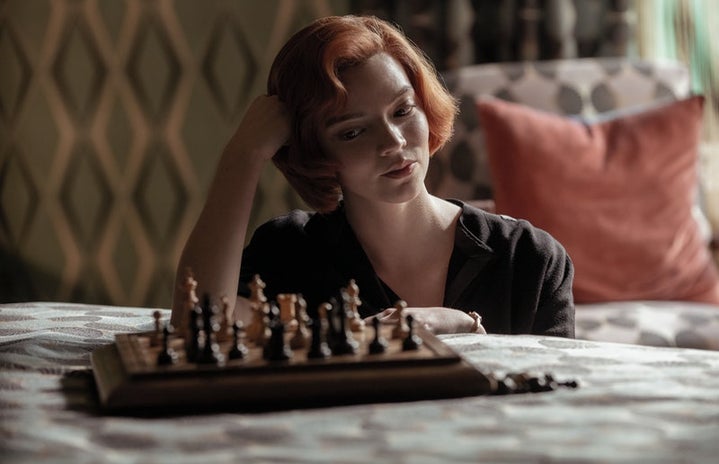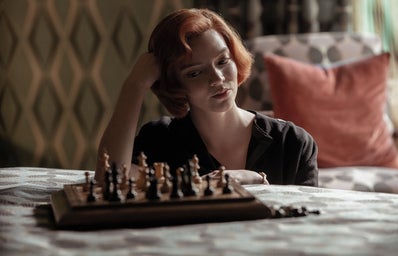I have always preferred to cozy up with a movie rather than a Netflix show, but The Queen’s Gambit caught my eye during an abnormally long winter break when my time begged to be used for such passive ventures. After watching the first three episodes alone, I told my parents to cancel their evening plans. Nothing they had planned in the era of COVID-19 could possibly compare to the experience of watching this limited series. I re-watched the first three episodes with them, watched the next episodes on my own, and continued this until I had seen the show twice in the span of a week. The next week, I roped in my sister and watched it a third time. My family and I practically became Evangelists for this show afterwards, imploring our friends, neighbors, and extended family to watch it with the utmost fervor. What makes The Queen’s Gambit so good?
First of all, Beth Harmon’s character is beautifully constructed. You can tell that she was written for paper before she was written for the screen, so Walter Tevis, the author of the book that the show was adapted from, should not go unmentioned. Beth is a certified genius, and watching her continuously succeed at chess is an exhilarating experience. However, her drug addiction, alcoholism, and awkward social interactions punctuate the story in a way that adds texture to her character so that she’s not just impressive; she’s intriguing. She keeps you highly invested. Her towering IQ and comparably low EQ create a perplexing hurricane of a person that viewers cannot take their eyes off of.

Second, The Queen’s Gambit is astoundingly aesthetically pleasing. Set in the sixties and featuring venues such as Las Vegas, Mexico City, New York, and Moscow, this one is easy on the eyes. Anya Taylor-Joy, who possesses striking beauty, is often dressed in costumes that feature a checkered pattern evoking a chess board. The set designers somehow found a way to make sixties decor look desirable, and you’d be lying if you don’t covet a pastel-colored refrigerator at least a little bit after watching the show. It’s not just the luxurious settings and vibrant wallpaper, however. The cinematography is gorgeous, filling scenes with a myriad of creative shots that never fail to add meaning to the story. Tying the experience together, a soundtrack of well-selected sixties classics and original orchestral music supports the overall aesthetic. The Queen’s Gambit appeals highly to every sense.
The theme of feminism stands out as an opportunity taken and well-executed. Beth understands that she is a black sheep in the world of chess as a woman, but she also understands that biological sex is not a determinant of intelligence nor talent. The brilliance of her chess moves should dazzle the chess magazines as her male counterparts’ do without mention that she is a woman. While this was an especially important lesson for the sixties, it is still shockingly relevant today. My aunt used to be a private pilot, and people would tell her that she “landed well for a girl.” She didn’t want to be a good female pilot; she just wanted to be a good pilot. The Queen’s Gambit reminds us that we must stop setting specific expectations for what women can and cannot do and start acknowledging that their talent, skill, and intelligence can have no end. Beth proves this in the same way many women advancing the feminist movement do: by setting a living (in this case, fictional) example. Feminism is far from being the only important theme, however. Addiction, redefinition of family, grief, and topics of race are also woven into the story.
“You have your gift, and you have what it costs.” This quote from Mr. Scheibel played on repeat like a broken record in my head after I heard it for the first time. Watching The Queen’s Gambit, I was sure that I would give almost anything to have a gift like Beth’s. As Jolene puts it, “You’ve been the best at what you do for so long, you don’t even know what it’s like for the rest of us.” Being the best at what we do is a dream that the majority of us must resign to living vicariously through a character like Beth. I thought back to Mr. Scheibel’s words, however, and asked myself: should we really want a gift like Beth’s? It cost her a significant slice of social life and a dangerous amount of mental stability. It also perpetuated an addiction. What’s more, she should have asked herself the same question she asked the thirteen-year-old Russian prodigy in Mexico City. What do you do once you’re the best in the world at your craft at such a young age? With sixty to eighty more years of life ahead of her and her talent already having achieved its end, the search for purpose and motivation must become significantly more difficult. The show prompts this sort of reflection.
Have you ever watched a movie that featured such a great story that you wished it were longer? Watching the Queen’s Gambit feels like finally getting to watch an extended version of that movie. Nevertheless, six and a half hours of it will leave you wanting more. The last reason why it is so good, however, lies in the fact that the show ends right where it should. The majority of viewers would undoubtedly love a second season, but it would not be prudent to continue Beth’s story and risk falling short of what has already been immaculately made.
I cannot recommend it enough.




